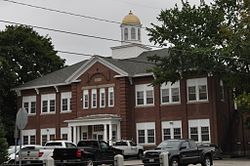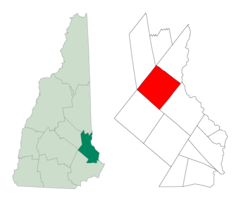Farmington, New Hampshire
| Farmington, New Hampshire | ||
|---|---|---|
| Town | ||

Farmington town hall
|
||
|
||
 Location within Strafford County, New Hampshire |
||
| Coordinates: 43°23′23″N 71°03′56″W / 43.38972°N 71.06556°WCoordinates: 43°23′23″N 71°03′56″W / 43.38972°N 71.06556°W | ||
| Country | United States | |
| State | New Hampshire | |
| County | Strafford | |
| Settled | 1770s | |
| Incorporated | 1798 | |
| Government | ||
| • Board of Selectmen | Charlie King, Chair Neil Johnson James Horgan Ann Titus Paula Proulx |
|
| • Town Administrator | Arthur Capello | |
| Area | ||
| • Total | 37.5 sq mi (97.2 km2) | |
| • Land | 37.2 sq mi (96.4 km2) | |
| • Water | 0.3 sq mi (0.8 km2) | |
| Elevation | 285 ft (87 m) | |
| Population (2010) | ||
| • Total | 6,786 | |
| • Density | 180/sq mi (70/km2) | |
| Time zone | EST (UTC-5) | |
| • Summer (DST) | EDT (UTC-4) | |
| ZIP code | 03835 | |
| Area code(s) | 603 | |
| FIPS code | 33-26020 | |
| GNIS feature ID | 0873596 | |
| Website | www |
|
Farmington is a town located in Strafford County, New Hampshire, United States. The 2010 census reported that the town had a total population of 6,786. Farmington is home to Blue Job State Forest.
The compact town center, where 3,885 people resided at the 2010 census, is defined by the U.S. Census Bureau as the Farmington census-designated place and is located at the junction of New Hampshire routes 75 and 153.
Abenaki Indians once used the Cochecho River for transportation, and had a camping ground on Meetinghouse Hill, where they built birch bark canoes. Otherwise, the river valley was wilderness, through which Indians from the north traveled after crossing Lake Winnipesaukee on their way to raid settlements in and around Dover. To stop the raids, in 1721 the Colonial Assembly in Portsmouth approved construction of a fort at the foot of the lake, with a soldiers' road built from Dover to supply it. In 1722, Bay Road was surveyed and completed. Along its course the town of Farmington would grow.
The settlement began as the Northwest Parish of Rochester, which was chartered in 1722. The last Indian attack in the general region occurred in 1748, but by 1749, Native Americans had disappeared from warfare and disease. Farmers cultivated the rocky soil, and gristmills used water power of streams to grind their grain. Sawmills cut the abundant timber, and the first frame house at the village was built in 1782. In 1790, Jonas March from Portsmouth established a store, behind which teamsters unloaded on his dock the lumber he traded. The area became known as March's Dock, Farmington Dock, and finally just The Dock.
...
Wikipedia

